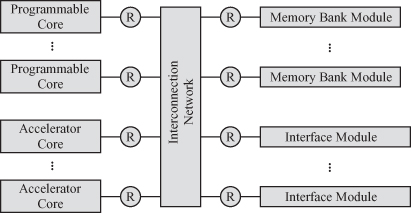3.9 MULTICORE SYSTEMS
A multicore system usually refers to a multiprocessor system that has all its processors on the same chip. It could also refer to a system where the processors are on different chips but use the same package (i.e., a multichip module). This close packing allows for very fast interprocessor communication without too much power consumption. For a dual or quad core system, the processors are connected using a simple bus. For a larger number of cores, the processors are interconnected using a network-on-chip (NoC) [13]. On the other hand, a multiprocessor system has its processors residing in separate chips and processors are interconnected by a backplane bus. It is possible to carry this further and to have a multiprocessor system where each chip is a multicore chip.
Multicore systems were developed primarily to enhance the system performance while limiting its power consumption. In other words, a multicore system has good performance even though its constituent cores are low-performing processors. By contrast, multiprocessor systems were developed to enhance the system performance with little regard to power consumption. A multiprocessor system has good performance and its constituent processors are high-performing processors. Table 3.2 summarizes the main differences between multicore systems and multiprocessor systems.
Table 3.2 Main Differences between Multicore Systems and Multiprocessor Systems
| Multiprocessor system | Multicore system | |
| Integration level | Each processor in a chip | All processors on the same chip |
| Processor performance | High | Low |
| System performance | Very high | High |
| Processor power consumption | High | Low |
| Total power consumption | Relatively high | Relatively low |
Figure 3.5 shows a sketch of a multicore processor. A multicore system consists of
1. general-purpose programmable cores,
2. special-purpose accelerator cores,
3. shared memory modules,
4. NoC (interconnection network), and
5. I/O interface.
Figure 3.5 A multicore microprocessor system.

Why move toward multicore systems? The main reason is scalability. As we increase the number of processors to enhance performance, multicore systems allow limiting power consumption and interprocessor communication overhead. A multicore system can be scaled by adding more CPU cores and adjusting the interconnection network. More system programming work has to be done to be able to utilize the increased resources. It is one thing to increase the number of CPU resources. It is another to be able to schedule all of them to do useful tasks.
Some of the possible applications that can be efficiently implemented on multicore systems include [31]
1. general-purpose multitasking computations,
2. network protocol processing,
3. encryption/decryption processing, and
4. image processing.
